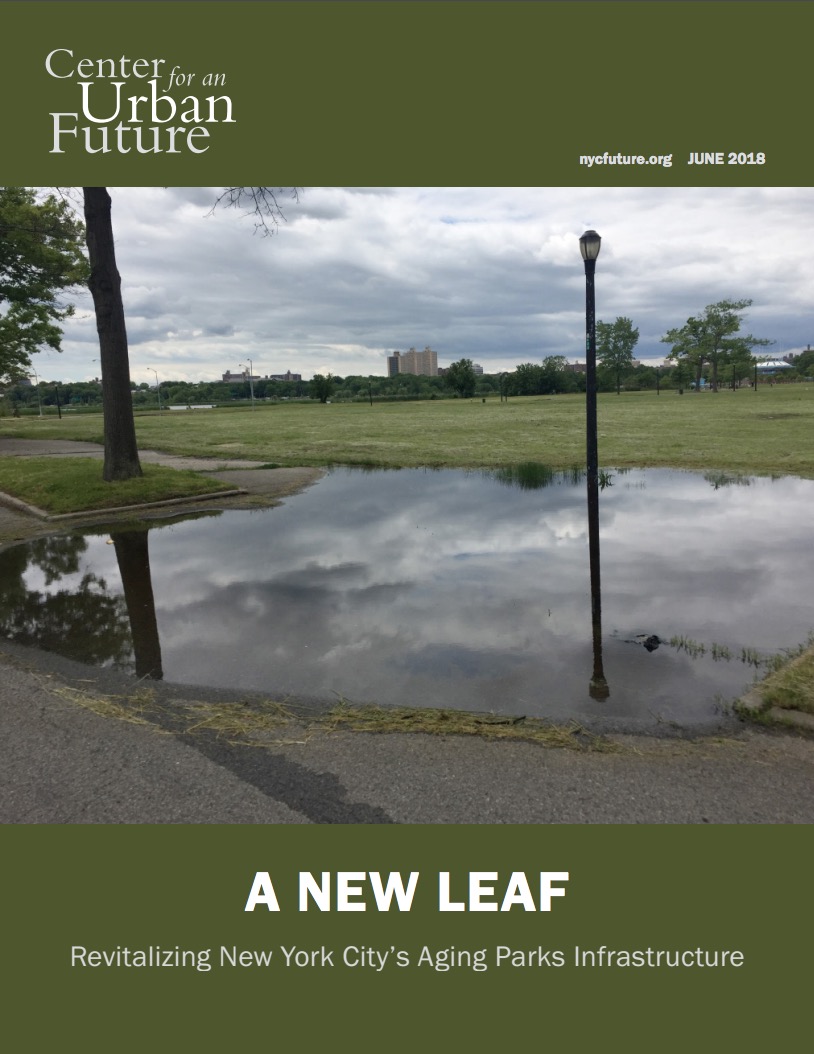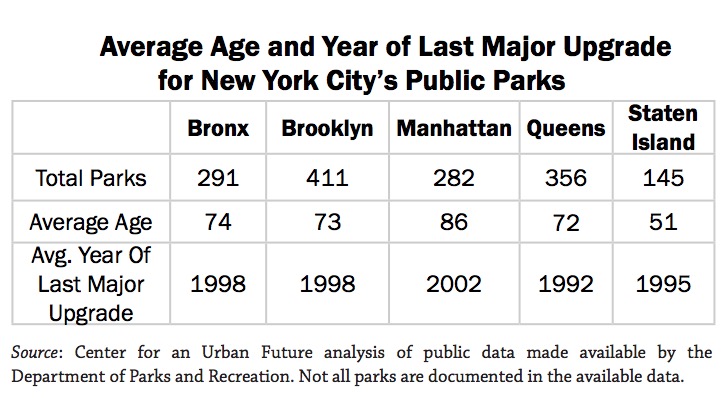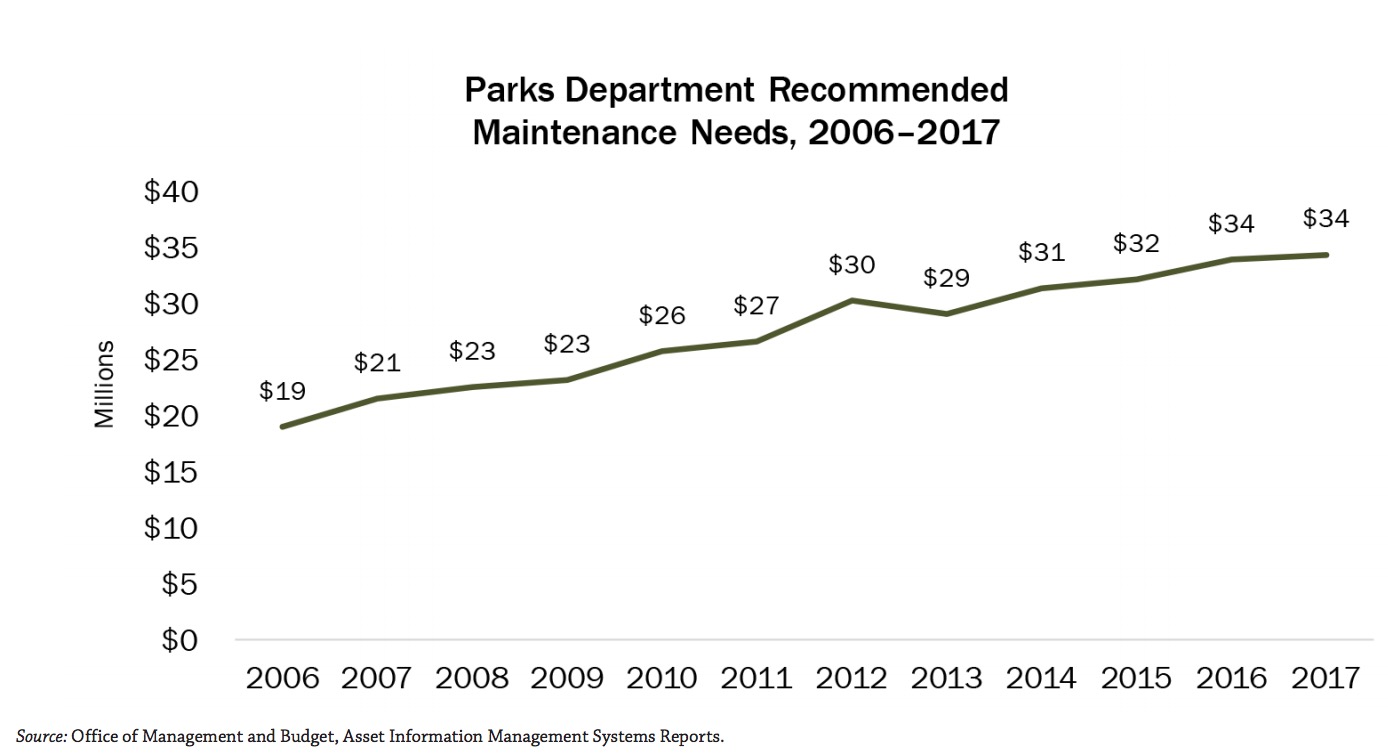CENTER FOR AN URBAN FUTURE
 In a space-starved city built from stone, brick, and steel, parks function as essential public infrastructure. These vital green spaces provide cost-free leisure and recreation in every corner of New York City, strengthening the economic and physical health of communities and providing a backyard for millions of residents. With the city’s population at an all-time high and record numbers of tourists, New York’s parks and playgrounds are busier—and more crucial—than ever before.
In a space-starved city built from stone, brick, and steel, parks function as essential public infrastructure. These vital green spaces provide cost-free leisure and recreation in every corner of New York City, strengthening the economic and physical health of communities and providing a backyard for millions of residents. With the city’s population at an all-time high and record numbers of tourists, New York’s parks and playgrounds are busier—and more crucial—than ever before.
But a significant share of the city’s public parks are several decades old, years behind on basic maintenance, and increasingly at risk of infrastructure failures. The average city park is 73 years old. Roughly 40 percent of the city’s pools were built before 1950, as were nearly half of the 53 recreation centers in parks citywide. Waterfront facilities in parks—piers, bulkheads, marinas, and docks—are, on average, 76 years old.
Despite all this, the average city park last saw a major renovation in 1997. According to the best available data, 20 percent of parks citywide have not undergone a major infrastructure upgrade in 25 years. Meanwhile, for decades New York City has provided too little money for basic maintenance and too few staff—including plumbers, masons, and gardeners—to keep critical parks assets from deteriorating and mitigate problems before they grow.
Although the city’s parks are not yet experiencing a full-blown maintenance crisis, serious cracks are showing. Many parks with old drainage systems experience flooding for days following a rain shower. Too many retaining walls in parks are near the end of their useful lifespan. More than 20 percent of inspected park bridges are seriously deteriorated. Just as years of underinvestment in New York’s century-old subway system led to a transit crisis, the maintenance challenges at city parks could quickly get a lot worse if more isn’t done to upgrade and maintain these aging assets.
To his credit, Mayor Bill de Blasio has taken some important steps to address these problems. Since 2014, the city has launched the Community Parks Initiative and Anchor Parks Initiative, directing hundreds of millions of dollars to improve chronically underfunded parks. The Parks Department is also overseeing the system’s first-ever needs assessment, which will begin to document the specific capital needs of the city’s more than 1,700 parks.
 However, much more will need to be done to shore up the city’s aging parks system. We estimate that the city will have to invest at least $5.8 billion over the coming decade to address the system’s infrastructure problems. This total only includes the known repair or replacement costs of existing infrastructure, not new structures or additions to parks.
However, much more will need to be done to shore up the city’s aging parks system. We estimate that the city will have to invest at least $5.8 billion over the coming decade to address the system’s infrastructure problems. This total only includes the known repair or replacement costs of existing infrastructure, not new structures or additions to parks.
This report identifies key elements of parks infrastructure most in need of revitalization, and provides a blueprint for bringing New York’s parks system into the 21st century.
This report, funded by the Stavros Niarchos Foundation, offers a new level of detail about the infrastructure needs of New York City’s parks—including invisible infrastructure, pathways, built facilities, and landscape—and encompasses both well-known facilities like playgrounds and bathrooms, and lesser-recognized yet integral components, such as drainage systems and retaining walls. The report also advances more than a dozen practical recommendations for city officials, designed to address the infrastructure challenges facing the city’s parks.
Researched and written by the Center for an Urban Future, A New Leaf is the culmination of a year of reporting and analysis on the current state of the city’s parks system. It is informed by an extensive analysis of data from the Department of Parks and Recreation (DPR), and interviews with over 90 park officials, park volunteers, open space advocates, elected officials, community board members, landscape architects, and horticulture experts in New York and nationwide. Our research also greatly benefited from consultation with New Yorkers for Parks, a citywide research and advocacy organization championing quality open space.
To supplement our research, we also visited 65 parks citywide—from southeastern Queens to the northern reaches of the Bronx; in high-, middle-, and low-income communities; and of all sizes—to document the most persistent problems. In one day alone, six researchers captured conditions at 30 parks across all five boroughs: a systemwide snapshot of the needs of New York City’s parks system on any given day.
New York’s parks are now some of the most frequented in the world, with over 100 million visits annually. While reflective of New York’s growing prosperity, this historically high usage places an unprecedented burden on the city’s parks infrastructure, which shortens the natural lifespans of amenities and increases the demand for regular maintenance. This rising need takes a toll on a system in which the average park was built before World War II. Across all five boroughs, most parks are at least half a century old: the average Brooklyn park is 73 years old; the Bronx, 74; Manhattan, 86; Queens, 72; and Staten Island, 51. A quarter of New York’s parks are at least 84 years old, and one park in 10 was built before 1898.
Problems exacerbated by the age of the parks system are compounded by deferred maintenance and a lack of infrastructure upgrades, which means that aging parks often go decades without significant investment in both aboveground and below-grade infrastructure. Based on this report’s analysis of historical records and capital projects data from the Parks Department, a city park saw its last major renovation, on average, in 1997. Citywide, 20 percent of parks have not undergone a major infrastructure upgrade in 25 years. That share is even higher for smaller parks: 34 percent of parks under one acre have gone at least two decades without significant capital work. Overall, at least 46 parks, triangles, and plazas in New York have not received significant capital investment in nearly a century. At least 5 of Brooklyn’s 411 parks saw their last major renovation in the 1980s. Nearly 70 percent of the parks in that borough were last renovated before 2000, while at least 39 Brooklyn parks haven’t received major capital work since opening, according to our analysis of the only available data—in eight cases, over 100 years ago. Queens has a total of at least 37 parks that are long overdue for revitalization, including at least six that haven’t undergone a major renovation for over 100 years, and 31 for over 50 years. Manhattan has at least six parks that haven’t been upgraded significantly in more than 100 years, and at least nine for over 50 years. Staten Island has at least seven parks that haven’t received any major upgrades for over 50 years.
Although some of these parks are likely to have received small-scale investments over the years, our research found no existing records of substantial renovations or upgrades in the Parks Department’s historical records, records of capital spending, or news reports. For example, Newtown Barge Playground in Greenpoint hasn’t received a major upgrade since 1972. Beach Channel Park, a 12-acre strip of waterfront land in the Rockaways, hasn’t been renovated since it was added to the parks system in 1930.
The numbers are particularly notable on the neighborhood level. In Woodside, 45 percent of parks haven’t received a major renovation since 1993. In Bushwick, the share is even higher, at 67 percent; in Riverdale, it’s 71 percent. The result is that hundreds of the city’s public parks are facing serious infrastructure challenges, whether from decaying drainage systems and crumbling bridges or leaking recreation centers and struggling horticulture.
Perhaps the most pressing infrastructure need is invisible: damaged or inadequate drainage systems below the ground and underwater that are hidden from view. Cracking, blocked, and insufficient drainage systems—the catch basins, sewers, and wastewater lines responsible for bringing water in and out of a park—impose one of the most challenging burdens on parks citywide. This is in part a function of age: in fact, many parks drainage systems still use clay pipes from the mid-20th century.
Today, many New York City parks can hardly handle the slightest downpour. Out of the 65 parks we surveyed, nearly half had notable drainage issues—more than two days after the last rain shower—including submerged pathways and flooded areas. At Forest Park in Queens, for example, multiple catch basins are collapsed, and several roads and paths flood every time in rains. Almost every park administrator we interviewed cited poor drainage as a major problem for the city’s parks. “We really struggle with drains,” says Susan Donoghue, administrator of Prospect Park and president of the Prospect Park Alliance. “We have incredible flooding, rivers that are forming in grassy areas, where there’s supposed to be turf. Our drains are old and broken and need to be fixed. It’s debilitating, and we can’t keep up.”
Of equal concern are the parks system’s retaining walls: the vertical structures that hold up hundreds of parks citywide, preventing landslides and forestalling erosion. Often built at the park’s inception and labor intensive to maintain, many retaining walls in parks are nearing the end of their lifespans and few had been comprehensively inspected until just the past year. For those walls that have been assessed, the price tag is high; recent reconstruction of retaining walls and seawalls at just eight parks citywide cost over $20 million. Some, like the crumbling 160-year-old wall holding up Fort Greene Park, could cost far more. “Virtually every retaining wall you see has a crack in it,” says one Parks Department official, who spoke with us on the condition of anonymity. “It’s a safety issue.”
The Parks Department is also responsible for 148 miles of coastline, including beaches, marinas, and docks— properties that are extremely expensive to maintain, yet integral to the health of the city’s coastline. However, due to rising costs, growing usage, and decades’ worth of deferred maintenance, the city’s piers, bulkheads, beaches, and marinas are increasingly vulnerable, leading to several recent collapses.
The waterfront facilities maintained by the Parks Department are 76 years old, on average, which is a highly advanced age for infrastructure that takes constant abuse from water and weather. According to the city’s most recent Asset Information Management System (AIMS) report, which tracks the condition and maintenance schedules for capital assets with a replacement cost of at least $10 million, the recommended maintenance needs for the Parks Department’s waterfront facilities was just $4.3 million in FY 2016—a number that barely captures a fraction of what the coastline demands. By comparison, reconstruction of the piers at the World’s Fair Marina in Queens, which had to be shut down due to damage from Sandy and long overdue maintenance, could ultimately cost more than $36 million. Experts agree that dozens of piers, seawalls, and bulkheads are likely to be in similar condition, but have not been inspected.
Park pathways—the roads, walking trails, sidewalks, and bridges that crisscross parkland—pose similar concerns due to age and wear, especially the city’s numerous park bridges. Many date to a park’s initial opening, with one in five inspected park bridges found to be seriously deteriorated. “Bridges are a big problem,” says one Parks Department official. “Several bridges were built during the 1930s and 1960s, and weren’t inspected until recently. They went under the radar. Because they weren’t in the system, some bridges weren’t regularly inspected.” According to the 2016 annual bridge survey by the Department of Transportation (DOT), 20.8 percent of all bridges operated in conjunction with the Parks Department received a rating below 4, which denotes “serious deterioration, or not functioning as originally designed.”2 One bridge—a pedestrian bridge in Flushing Meadows Corona Park on the south side of Willow Lake—received a 1 for its condition, meaning “potentially hazardous.”
Built facilities in city parks, especially park bathrooms, also pose significant infrastructure challenges. The structures are often as old as a park, leaving them highly susceptible to gradual deterioration. In other cases, a lack of modern plumbing means that bathrooms haven’t been used in years. Our researchers observed issues at nearly half of the parks we surveyed citywide, including flooding, broken fixtures, or nonfunctional toilets. Many of the comfort stations surveyed were closed entirely.
Unlike many other components of the parks system, this report finds playgrounds to be in a much-improved state of repair. But many residents and neighborhood advocates in low- and middle-income communities say that their playgrounds too often feature broken or decaying equipment and lack the modern play surfaces and structures of better-funded parks. “Thomas Jefferson Park had one of the highest playground injury rates in the city,” says Marie Winfield, founder of Friends of Thomas Jefferson Park and a former member of Manhattan Community Board 11’s parks committee, in East Harlem. “Harlem River Park is another one. It’s just general disrepair—things that are broken with the playgrounds. For the rest of the smaller parks, it’s the same sorts of issues.” Our data analysis finds that 63 of the city’s playgrounds have not received major capital investment in over 50 years. This pattern is especially prevalent in Queens, where approximately 25 of the borough’s 66 listed playgrounds saw their last major renovation in the 1960s or earlier, according to our analysis of the only available records.
Nearly half of the city’s DPR-operated recreation centers were built prior to 1950, resulting in frequent roof leaks, broken HVAC systems, and chronic plumbing and electrical problems.3 Likewise, 40 percent of park pools were built in the 1930s, all of which—aside from McCarren Park Pool, which is still undergoing restoration work—saw their last major renovation in the 1980s.
In addition to various built structures, the city’s diverse park landscapes—including horticulture, natural areas, and trees—face serious infrastructure challenges of their own. Our survey identified horticultural problems, such as dead plantings or rampant weeds, at over 35 percent of the 65 parks visited. The result is that many parks lack anything but the most minimal plantings—and even those are a struggle to maintain.
The challenges facing parks infrastructure did not appear overnight. Instead, they are the result of underinvestment in repair and maintenance over the course of decades and a system that makes it uniquely difficult to prioritize infrastructure when compared to other cities. Our research finds five key drivers of the parks system’s infrastructure problems, which will have to be addressed in order to make lasting progress.
Download full version (PDF): A New Leaf
About Center for an Urban Future
nycfuture.org
The Center for an Urban Future (CUF) is a catalyst for smart and sustainable policies that reduce inequality, increase economic mobility, and grow the economy in New York City. An independent, nonpartisan policy organization, CUF uses fact-based research to elevate important and often overlooked issues onto the radar of policymakers and advance practical solutions that strengthen New York and help all New Yorkers participate in the city’s rising prosperity.
Tags: Central Park, New York, New York City, New York City Parks, NY, NYC, parks







 RSS Feed
RSS Feed